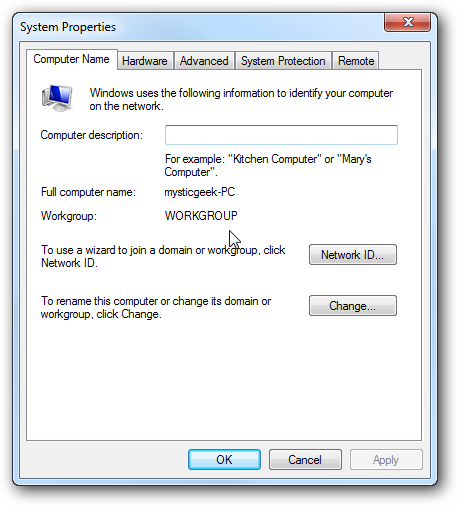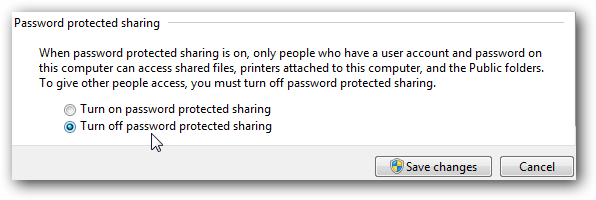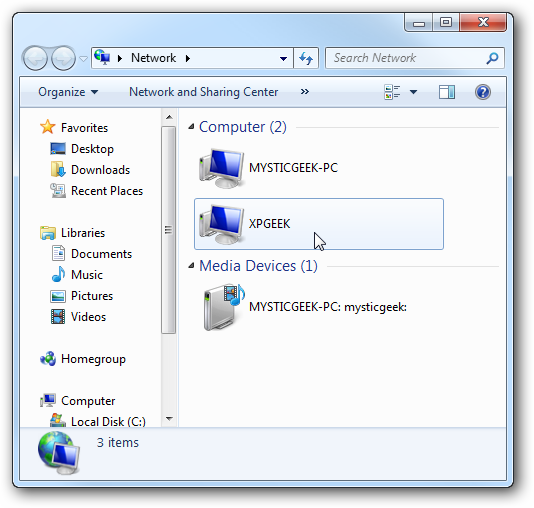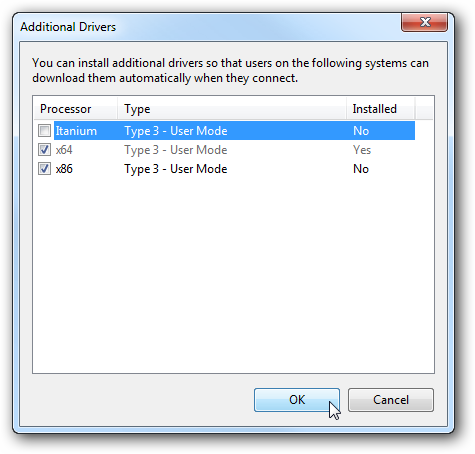This is a general checklist for sharing files between PCs in a peer
to peer network. There can be other reasons for problems but I think
most people new to networking and finding sharing a problem will find
the answer somewhere in this checklist.
These checks are all necessary for sharing to work with TCP/IP.
- PCs which are not XP must have TCP/IP installed.
- Each PC must have a unique computer name.
- Each PC must have a network share defined.
- ALL NICS must be on the same subnet (e.g. IP 192.168.0.* subnet mask 255.255.255.0).
- XP PCs must have Netbios over TCP/IP enabled (only essential for XP to talk to W9X PCs).
- MS Client and file and printer sharing must be enabled on each NIC.
- All NICs must have their node type = anything except p-node (peer to peer, or point-point). Check at cmd prompt with Ipconfig /all (XP/W2K) or winipcfg (W9X).
- XP's ICF firewall is permanently disabled. (Only necessary for pre XP SP2).
- All 3rd party firewalls are disabled, uninstalled and deleted (until connection is working).
- PCs have the same workgroup (helps, but not essential).
Allow 15 mins after rebooting a PC for that PC to appear in the workgroup, or for it to see all other PCs. Or you can search for the PC by its computer name.
If all the above checked out and still a problem check these:
Other ideas:
- Realtek cards have been known to be a problem with IRQ conflicts. Move the Realtek card to another PCI slot.
- Check your Services are Started on all PCs: Workstation, Server, TCP/IP Netbios helper, Computer Browser.
- You only need TCP/IP. NWLink NetBIOS, NWLink IPX/SPX/NetBIOS Compatible Transport Protocol are not needed and can confuse things. Remove them.
- XP gives access to its shares via the Guest Account. (Note, the local guest account in user accounts which should be off).
Net Guest Account access is enabled by default in XP, but check it:
At command prompt:
Net user guest
Should return a line with 'Account active yes'.
If not active use:
Net user guest /active:yes
(Still leave the user guest account off)
See link for explanation of guest account:
- PCs which are not XP must have TCP/IP installed.
- Each PC must have a unique computer name.
- Each PC must have a network share defined.
- ALL NICS must be on the same subnet (e.g. IP 192.168.0.* subnet mask 255.255.255.0).
- XP PCs must have Netbios over TCP/IP enabled (only essential for XP to talk to W9X PCs).
- MS Client and file and printer sharing must be enabled on each NIC.
- All NICs must have their node type = anything except p-node (peer to peer, or point-point). Check at cmd prompt with Ipconfig /all (XP/W2K) or winipcfg (W9X).
- XP's ICF firewall is permanently disabled. (Only necessary for pre XP SP2).
- All 3rd party firewalls are disabled, uninstalled and deleted (until connection is working).
- PCs have the same workgroup (helps, but not essential).
Allow 15 mins after rebooting a PC for that PC to appear in the workgroup, or for it to see all other PCs. Or you can search for the PC by its computer name.
If all the above checked out and still a problem check these:
Other ideas:
- Realtek cards have been known to be a problem with IRQ conflicts. Move the Realtek card to another PCI slot.
- Check your Services are Started on all PCs: Workstation, Server, TCP/IP Netbios helper, Computer Browser.
- You only need TCP/IP. NWLink NetBIOS, NWLink IPX/SPX/NetBIOS Compatible Transport Protocol are not needed and can confuse things. Remove them.
- XP gives access to its shares via the Guest Account. (Note, the local guest account in user accounts which should be off).
Net Guest Account access is enabled by default in XP, but check it:
At command prompt:
Net user guest
Should return a line with 'Account active yes'.
If not active use:
Net user guest /active:yes
(Still leave the user guest account off)
See link for explanation of guest account:
http://support.microsoft.com/kb/300489/
Check XP Security policies:
- Access this computer from the network: add guest
- Deny logon locally: remove guest
- Network access:Sharing and security model... -- Guest only
- Deny access to this computer from the network-- check Guest is not here.
Other useful guides for step by step sharing are available here:
http://practicallynetworked.com/shar...ilesharing.htm
MS Tech D/B
http://support.microsoft.com/default...&Product=winxp
and here:
http://www.homenethelp.com/web/howto/net.asp
Developing a SOHO network, sharing and security (by MS):
http://www.microsoft.com/windowsxp/p...et/default.asp
How to share a printer and connect to a shared printer:
http://www.microsoft.com/downloads/d...DisplayLang=en
Ports to open in a firewall for various applications:
http://www.microsoft.com/security/protect/ports.asp
I will try to develop these checks with time. If you have suggestions to add/improve the checklist feel free to post your ideas.
If you have a network problem please start your own thread with the problem. Please do not post your problem here or reply to this thread.
Check XP Security policies:
- Access this computer from the network: add guest
- Deny logon locally: remove guest
- Network access:Sharing and security model... -- Guest only
- Deny access to this computer from the network-- check Guest is not here.
Other useful guides for step by step sharing are available here:
http://practicallynetworked.com/shar...ilesharing.htm
MS Tech D/B
http://support.microsoft.com/default...&Product=winxp
and here:
http://www.homenethelp.com/web/howto/net.asp
Developing a SOHO network, sharing and security (by MS):
http://www.microsoft.com/windowsxp/p...et/default.asp
How to share a printer and connect to a shared printer:
http://www.microsoft.com/downloads/d...DisplayLang=en
Ports to open in a firewall for various applications:
http://www.microsoft.com/security/protect/ports.asp
I will try to develop these checks with time. If you have suggestions to add/improve the checklist feel free to post your ideas.
If you have a network problem please start your own thread with the problem. Please do not post your problem here or reply to this thread.
TCP/IP File Sharing Checklist
Wireless a/b/g
If you are waiting a reply from me and none appears, Personal Message me to get my attention.
Note: My views are based on my personal experience and do not represent practicallynetworked.com
Wireless a/b/g
If you are waiting a reply from me and none appears, Personal Message me to get my attention.
Note: My views are based on my personal experience and do not represent practicallynetworked.com
===========================
Source
Vista asks for password trying to connect to other Vista PC












Source
Vista asks for password trying to connect to other Vista PC
Click Start - Network - Network and Sharing:
Password Protected: OFF (unless you want to set up identical usernames and passwords on ALL computers in your Network) If you have it ON, and no identical usernames/passwords set up, you will be asked for a username and password when you try to access a Vista computer from an XP computer, or a
Vista computer.
Password Protected: OFF (unless you want to set up identical usernames and passwords on ALL computers in your Network) If you have it ON, and no identical usernames/passwords set up, you will be asked for a username and password when you try to access a Vista computer from an XP computer, or a
Vista computer.
-------------
Make sure you can ping the Vista machine from the XP and with that being successful, try this tutorial I put together:
http://willsit.com/XP_Vista.aspx
http://willsit.com/XP_Vista.aspx
XP and Vista Networking within a Home Network
Many
critics of Microsoft products have thru the years have blamed those
products with a lack of security, and sometimes rightly so. Microsoft
does everything possible to lock down those products and everyone starts
complaining this it is now “broken”.
Well, it is not broken but there a couple of issues you need to resolve and configure to make these two systems “talk” to one another. By “talking” to one another, we mean sharing resources across your home network. Resources could be anything from music files, pictures, or even a printer. In this section, show you the new settings within Vista you need to consider and configure. Vista sees two types of networks, Public and Private.
Navigate to the Network and Sharing Center and take a look at the new features. You will see you connection to the internet and whether it is designated as Private or Public. This would have been determined at the time you made you connection to the internet. For the moment, let’s deal with a private network, which is your network at home. You must have a "Private" network in order to share files within your home environment.
Well, it is not broken but there a couple of issues you need to resolve and configure to make these two systems “talk” to one another. By “talking” to one another, we mean sharing resources across your home network. Resources could be anything from music files, pictures, or even a printer. In this section, show you the new settings within Vista you need to consider and configure. Vista sees two types of networks, Public and Private.
Navigate to the Network and Sharing Center and take a look at the new features. You will see you connection to the internet and whether it is designated as Private or Public. This would have been determined at the time you made you connection to the internet. For the moment, let’s deal with a private network, which is your network at home. You must have a "Private" network in order to share files within your home environment.

Hit "Customize" on the right side of the panel to make any needed changes.
What we want is a "Private Network" with any name you deisre to identify your network.
Choose Private and complete the wizard.

By
default, Public File Sharing will de disabled. We have been talking
about a Public folder so just where is it located? Go to the C
Drive>Users>Public and within there you will see the “Public
Folders”.

Among
these there are folders for Documents, Music, Pictures, etc. At this
point, only users on the local machine have access to this folder as
shown in the graphic below:

Special caveat at this point. These instructions will allow access to
the built in Public Folder from within your local network
Hit the drop down arrow on the right side of the panel and you will be presented with three options:
• Turn on sharing so anyone with network access can open files
• Turn on sharing so anyone with network access can open, change, and create files
• Turn off sharing (people logged onto this machine can still access this folder)
• Turn on sharing so anyone with network access can open, change, and create files
• Turn off sharing (people logged onto this machine can still access this folder)

Special Note:
Option #1 menas that users from another machine can "Read' files withn the public folder
Option #2 means that users from another network machin can "Read, Change, abd Create" Files within the public folder
Option #3 only allows access to user logged on to the local machine, i.e., no network access.
You could circumvent this by enabling the Guest Account but this is not encouraged.
Open,
Create, and Change Files are the same as “Modify” within NTFS
permissions. NTFS permissions are an advanced set of permissions used by
operating systems since Windows 2000 was introduced. No access means
just that. The folder is only available to local users on the Vista
machine.
In the graphic below you see a Vista machine named VMVista connected to the internet from within a Private Network. My Workgroup name is named “Wills”. Public File Sharing has been turned on for Network users to “Open, Change, and Create “files. My XP machine (Dell1705) has a Username “John Wills” and so does the Vista machine. I can either “map” a drive to the Public Folder or use “Explorer” to use it.
In the graphic below you see a Vista machine named VMVista connected to the internet from within a Private Network. My Workgroup name is named “Wills”. Public File Sharing has been turned on for Network users to “Open, Change, and Create “files. My XP machine (Dell1705) has a Username “John Wills” and so does the Vista machine. I can either “map” a drive to the Public Folder or use “Explorer” to use it.

We
can now get to the Public Folder, but what about if you want to create a
"special" Shared Folder in which you want to restrict access. This
would mean that although a User might have an account on the target
Vista machine, you can deny access to this new folder.Go to the C drive
and create a new folder named “Test”.

Right
click the folder and go to Properties. You will see the Security and
Sharing tabs (in version Home Premium and Ultimate). Hit the Sharing tab
and you are now presented with a couple of options. Look for a button
named Share and hit it and you see the box below:


Continuing
with the example, I have created a new user named "Network User" choose
“Network User” (a local user on my Vista and XP machine) and select
add. Hit the Permission Level and determine the level of access they
need. Hit the Share button and complete the process. In this case,
“Network User” will be given “Reader” access.


Now hit the "Share" button and you will now see the newly created Shared Folder.

This
folder is now accessable from the XP machine on the network by either
mapping a Network Drive or using the "Explorer" Method.
Go to My Computer and in the Explorer URL type:
and you will see the folders accessable to you.
**Note**
Subsituite the correct name of your Vista machine for this example to work for you.
The
owner of the folder (the user who created it) has by default full
access to that folder. Now you can add named users on the network or
something unique named “Everyone”. This is basically the same process
you went thru in the previous example but now you begin to see how the
process works. The “Permissions” that you can give to any user are:
1. Reader (Default)
2. Contributor – this means the user can modify the data
3. Co-Owner – gives the user full access to the entire folder
4. Remove (after action)
1. Reader (Default)
2. Contributor – this means the user can modify the data
3. Co-Owner – gives the user full access to the entire folder
4. Remove (after action)
Something
to note. “Everyone” means EVERYONE. Anyone who gains or has access to
your network has access to and file or folder with the Everyone
permission. A better plan of action would be to give a specific user the
permissions they need otherwise put data that “Everyone” needs access
to in the Public folder. Beginning to make sense?Continuing
with the example, I have created a new user named "Network User" choose
“Network User” (a local user on my Vista and XP machine) and select
add. Hit the Permission Level and determine the level of access they
need. Hit the Share button and complete the process. In this case,
“Network User” will be given “Reader” access.
At
times this can get confusing but the key to remember is properly
allocate permissions. My examples were created with a "virtual" Vista
machine using VM Ware and the host machine running XPSP2.
============================
If you have a home network and are running Windows 7 and have XP
on other PC(s) you might want to share files between them. Today we
will look at the steps to share files and hardware devices like a
printer.
Sharing Files In Windows 7 and XP
Sharing folders between two Windows 7 machines with the new HomeGroup feature is an easy process, but the HomeGroup feature is not compatible with Vista or XP. For this tutorial we are using Windows 7 x64 RC1 and XP Professional SP3 connected through a basic Linksys home wireless router.
First make sure both machines are members of the same Workgroup which by default is named Workgroup.

On the Windows 7 machine go into Control Panel \ All Control Panel Items \ Network and Sharing Center then click on Change advanced sharing settings.


You will want to verify the following settings under Advanced Sharing Settings for the Home or Work and Public profile.

If you want any user to have access the public shares turn off password protection. This is located in Advanced Sharing Settings toward the bottom of the list.

If you want to keep it enabled make sure there is a log in account for the other XP machines and they have a password.

Now if you go into Network in Windows 7 you should see your XP machine and the Windows 7 as well which in this case is Mysticgeek-PC.

To share the printer on the Windows 7 machine go into Devices and Printers from the Start menu and double click on the printer icon.

Next double click on “Customize your printer”.

In the Properties screen click on the Sharing Tab and check the box to share the printer and type in its share name.

If your XP machine is an x86 OS you can install Additional Drivers before setting up the XP machine.

To find the shared folders and devices double click on the Windows 7 machine icon under Network. Here you can see the printer connected to my Windows 7 machine is shared and also the Users Folder.

Continue into the Users folder and Public to see the shared folders, here I also created a folder called XP Share just to keep everything in central location.

Over on your XP machine open up My Network Places to find the Windows 7 (mysticgeek-pc) shared folder.

Double click on the Share folder to find a list of shared folders in the Public folder on Windows 7. If you have password protection enabled you will need to type in the username and password of the user account on the Windows 7 machine first.

Setup XP With Shared Printer
To set up the shared printer in XP you will need to go into Printers and Faxes from the Start menu and kick off the Add Printer Wizard.

Now select “A network printer, or a printer attached to another computer” then hit Next.

Next select “Connect to this printer…” and type in the path for the printer connected to the Windows 7 machine and click next.

Now click Yes to the confirmation message.

Then click Finish the printer to install and complete the Wizard.

In some cases you will need to install the x86 XP drivers for the shared printer because the Windows 7 drivers are not compatible with XP. When everything is installed open up Printers and Faxes to find the shared printer.

This should help you get started with sharing your files and other devices with your Windows 7 machine. When I first started I was able to see the printer on XP right away because I had a HomeGroup set up, but once I deleted it I needed to share the printer like you would for a workgroup. You might also have to do a couple restarts of the XP machine for it to see the shared resources on Windows 7. If you have had any experiences with sharing between Windows 7 and XP leave us a comment!
Sharing Files In Windows 7 and XP
Sharing folders between two Windows 7 machines with the new HomeGroup feature is an easy process, but the HomeGroup feature is not compatible with Vista or XP. For this tutorial we are using Windows 7 x64 RC1 and XP Professional SP3 connected through a basic Linksys home wireless router.
First make sure both machines are members of the same Workgroup which by default is named Workgroup.

On the Windows 7 machine go into Control Panel \ All Control Panel Items \ Network and Sharing Center then click on Change advanced sharing settings.


You will want to verify the following settings under Advanced Sharing Settings for the Home or Work and Public profile.

If you want any user to have access the public shares turn off password protection. This is located in Advanced Sharing Settings toward the bottom of the list.

If you want to keep it enabled make sure there is a log in account for the other XP machines and they have a password.

Now if you go into Network in Windows 7 you should see your XP machine and the Windows 7 as well which in this case is Mysticgeek-PC.

To share the printer on the Windows 7 machine go into Devices and Printers from the Start menu and double click on the printer icon.

Next double click on “Customize your printer”.

In the Properties screen click on the Sharing Tab and check the box to share the printer and type in its share name.

If your XP machine is an x86 OS you can install Additional Drivers before setting up the XP machine.

To find the shared folders and devices double click on the Windows 7 machine icon under Network. Here you can see the printer connected to my Windows 7 machine is shared and also the Users Folder.

Continue into the Users folder and Public to see the shared folders, here I also created a folder called XP Share just to keep everything in central location.

Over on your XP machine open up My Network Places to find the Windows 7 (mysticgeek-pc) shared folder.

Double click on the Share folder to find a list of shared folders in the Public folder on Windows 7. If you have password protection enabled you will need to type in the username and password of the user account on the Windows 7 machine first.

Setup XP With Shared Printer
To set up the shared printer in XP you will need to go into Printers and Faxes from the Start menu and kick off the Add Printer Wizard.

Now select “A network printer, or a printer attached to another computer” then hit Next.

Next select “Connect to this printer…” and type in the path for the printer connected to the Windows 7 machine and click next.

Now click Yes to the confirmation message.

Then click Finish the printer to install and complete the Wizard.

In some cases you will need to install the x86 XP drivers for the shared printer because the Windows 7 drivers are not compatible with XP. When everything is installed open up Printers and Faxes to find the shared printer.

This should help you get started with sharing your files and other devices with your Windows 7 machine. When I first started I was able to see the printer on XP right away because I had a HomeGroup set up, but once I deleted it I needed to share the printer like you would for a workgroup. You might also have to do a couple restarts of the XP machine for it to see the shared resources on Windows 7. If you have had any experiences with sharing between Windows 7 and XP leave us a comment!



 LibreOffice
LibreOffice Firefox
Firefox
No comments:
Post a Comment